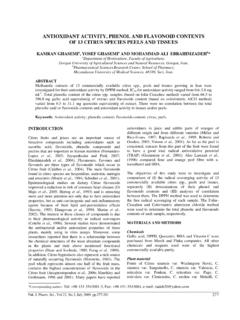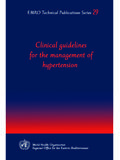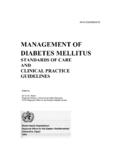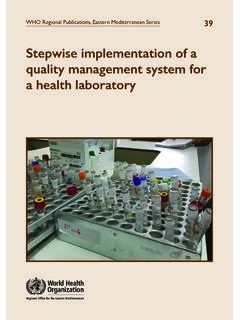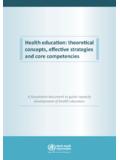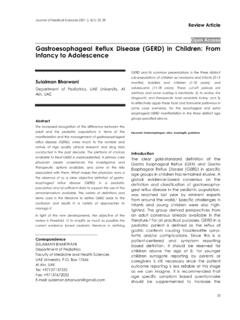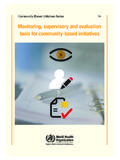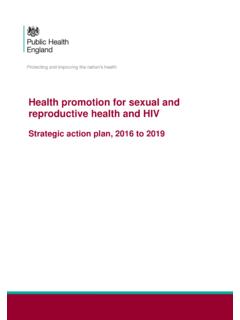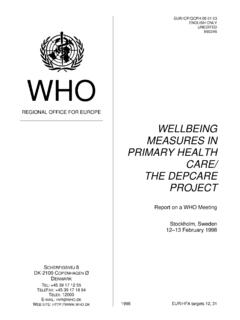Transcription of Introduction to hIv, aIds and sexually transmitted infection …
1 Who-EM/STD/126/E. Introduction to hiv, aids and sexually transmitted infection surveillance MODULE 2. Surveillance of hiv risk behaviours WHO-EM/STD/126/E. Introduction to hiv, aids and sexually transmitted infection surveillance MODULE 2. Surveillance of hiv risk behaviours who Library Cataloguing in Publication Data World Health Organization. Regional Office for the Eastern Mediterranean Introduction to HIV, aids and sexually transmitted infection surveillance: Module 2: Surveillance of HIV risk behaviours / World Health Organization. Regional Office for the Eastern Mediterranean, Joint United Nations Programme on HIV/ aids . p. WHO-EM/STD/126/E. 1. Acquired Immunodeficiency Syndrome epidemiology Middle East Africa, Northern 2.
2 HIV Infections epidemiology Middle East Africa, Northern 3. sexually transmitted Diseases epidemiology Middle East Africa, Northern 4. Population Surveillance Middle East Africa, Northern 5. Risk Reduction Behaviour 6. Information Seeking Behaviour I. Title II. Regional Office for the Eastern Mediterranean III. Joint United Nations Programme on HIV/ aids . (NLM Classification: WC ). World Health Organization 2010. All rights reserved. The designations employed and the presentation of the material in this publication do not imply the expression of any opinion whatsoever on the part of the World Health Organization concerning the legal status of any country, territory, city or area or of its authorities, or concerning the delimitation of its frontiers or boundaries.
3 Dotted lines on maps represent approximate border lines for which there may not yet be full agreement. The mention of specific companies or of certain manufacturers' products does not imply that they are endorsed or recommended by the World Health Organization in preference to others of a similar nature that are not mentioned. Errors and omissions excepted, the names of proprietary products are distinguished by initial capital letters. All reasonable precautions have been taken by the World Health Organization to verify the information contained in this publication. However, the published material is being distributed without warranty of any kind, either expressed or implied.
4 The responsibility for the interpretation and use of the material lies with the reader. In no event shall the World Health Organization be liable for damages arising from its use. Publications of the World Health Organization can be obtained from Distribution and Sales, World Health Organization, Regional Office for the Eastern Mediterranean, PO Box 7608, Nasr City, Cairo 11371, Egypt (tel: +20 2 2670 2535, fax: +20 2 2670 2492; email: Requests for permission to reproduce, in part or in whole, or to translate publications of WHO Regional Office for the Eastern Mediterranean whether for sale or for noncommercial distribution should be addressed to WHO, Regional Office for the Eastern Mediterranean, at the above address; email: Design by Permanent Design.)
5 Printed by the WHO Regional Office for the Eastern Mediterranean. Contents Introduction 7. How to use this module 7. Additions, corrections, suggestions 8. Acknowledgements 9. UNIT 1 Behavioural surveillance 11. Overview 13. What this unit is about 13. Warm-up questions 13. Introduction 15. Steps for conducting behavioural surveillance 22. Summary 26. Unit 1 exercises 27. UNIT 2 Measures and indicators for behavioural surveillance 29. Overview 31. What this unit is about 31. Warm-up questions 31. Introduction 33. Selecting indicators for behavioural surveillance 33. Standardized versus locally-adapted indicators 35. Summary 35. Unit 2 exercises 36. UNIT 3 Formative assessment 37.
6 Overview 39. What this unit is about 39. Warm-up questions 39. Introduction 41. Formative assessment methods 43. Qualitative data collection methods 46. Rapid assessment tools 51. Building alliances 53. Specific ethical considerations for conducting formative assessment 54. Summary 55. Unit 3 exercises 55. 3. 4 Surveillance of hiv risk behaviours UNIT 4 Survey methods 57. Overview 59. What this unit is about 59. Warm-up questions 59. Introduction 61. Data collection methods 61. Survey instruments 61. Measurement error 63. Fieldwork practicalities 67. Selecting appropriate interviewers and supervisors 69. Summary 69. Unit 4 exercises 70. UNIT 5 Sampling 71. Overview 73.
7 What this unit is about 73. Warm-up questions 73. Introduction 75. Concepts, terms and definitions 75. Selecting a sample 76. Calculating sample size 78. Additional issues in calculating sample size 81. Probability sampling techniques 84. Sampling most-at-risk populations 85. Sampling options in the absence of a sampling frame 87. New sampling techniques 88. Determining sampling approach 90. Summary 92. Unit 5 exercises 92. Appendix Summary of probability sampling techniques 94. Appendix Formula for sample size calculation to detect change in proportion 96. Appendix Random numbers table and instructions 98. UNIT 6 Data analysis and use 103. Overview 105. What this unit is about 105.
8 Warm-up questions 105. Introduction 107. Data management issues and activities 107. Data analysis 108. Using behavioural surveillance data 110. Summary 113. Unit 6 exercises 114. UNIT 7 Ethical considerations 115. Overview 117. What this unit is about 117. Warm-up questions 117. Introduction 119. Ethical principles of conducting human subjects research 119. Contents 5. Informed consent 120. Confidentiality 121. Ethical considerations unique to behavioural surveillance 122. Summary 125. Unit 7 exercises 126. Appendix Samples of verbal consent forms for participation in hiv biological and behavioural surveillance surveys 127. Appendix Declaration of Helsinki on Ethical Principles for Medical Research Involving Human Subjects 129.
9 Final case studies 135. Final case study 1 Part 1 137. Part 2 138. Part 3 138. Final case study 2 Part 1 139. Part 2 139. Part 3 140. Part 4 140. Final case study 3 Part 1 141. Part 2 141. Part 3 142. Module summary 143. References 149. Annex 1 Glossary 153. Annex 2 Useful links 163. Annex 3 Answers to warm-up questions and case studies 169. Unit 1 answers 171. Unit 2 answers 173. Unit 3 answers 174. Unit 4 answers 176. Unit 5 answers 178. Unit 6 answers 181. Unit 7 answers 183. Final case study answers 184. Annex 4 Action plan for implementing hiv behavioural surveillance of most-at-risk populations in emr/mena countries 193. Introduction 195. What is an action plan?
10 195. National action plan worksheet 196. Introduction How to use this module What you should know before the course The human immunodeficiency virus (HIV)/acquired immunodeficiency syndrome ( aids ) epidemic continues to grow worldwide and to devastate individuals, communities and entire countries and regions. Behavioural surveillance measures trends in the behaviours that can lead to HIV infection . It has been shown to make an important and useful contribution to national responses to HIV. Conducting behavioural surveillance requires many skills, including coordination among various partners. Although there are useful reference materials available for behavioural surveillance, there has not yet been a comprehensive effort to train surveillance teams.
